How to Automate Your API Testing
This article explores the challenges of manual API testing and the benefits of using Apidog for automated API testing and collaboration.
"Experience unparalleled efficiency in API testing automation with Apidog, the ultimate tool for modern development workflows!"
In the dynamic world of software development, APIs are the glue that binds various systems together, enabling seamless communication and integration. With the growing complexity of these systems, API testing has become a crucial aspect of the development process.
Welcome to an exploration of automated API testing, where we'll delve into the powerful benefits of automation and reveal how it can revolutionize your development workflow. So, let's embark on this captivating adventure and unlock the full potential of automated API testing together!
The Challenges of Manual API Testing
Manual API testing has long been the traditional approach to ensure that APIs function correctly, securely, and efficiently in software development. However, manual testing has revealed several limitations as software systems have grown increasingly complex and interconnected. Some of the limitations of Manual API Testing are stated below:
Time-Consuming:
Manually testing APIs is a labor-intensive process requiring significant time and resources from development teams. This method becomes even more cumbersome and time-consuming as the number of APIs and test cases increases.
Human Error:
Manual testing is prone to human error, leading to inconsistencies in test results and potentially undetected issues. This lack of reliability can compromise the overall quality of the software.
Limited Test Coverage:
It's nearly impossible to manually test every possible combination of input parameters and scenarios, especially as APIs grow more complex. As a result, manual testing often needs to improve in terms of comprehensive test coverage.
Difficult to Scale:
Manual testing becomes increasingly challenging as software systems evolve and expand. The effort required to maintain and update test cases grows exponentially, making it harder to keep up with the rapid pace of development.
The Emergence of Automated API Testing
To overcome these challenges and streamline the API testing process, automated API testing has emerged as a powerful and efficient solution. Automated API testing ensures API's functionality, reliability, and security, allowing seamless communication between different software systems. You can deliver the best possible user experience by effectively verifying that APIs return the correct responses for various input parameters and handling errors. By automating test execution and management, teams can unlock numerous benefits, including:
Accelerated Test Execution:
Automated tests run at breakneck speeds compared to their manual counterparts, allowing your team to evaluate more scenarios within the same time frame. This increased efficiency enables you to maintain a faster development pace and deliver high-quality APIs to the market more quickly.
Consistency and Precision:
Automation drastically reduces the risk of human error, ensuring that your test results are consistently accurate and reliable. By eliminating the inconsistencies that can arise from manual testing, you can be confident in the quality and performance of your APIs.
Seamless Maintenance and Adaptability:
Maintaining and updating your automated tests becomes seamless as your APIs evolve. This adaptability ensures that your tests remain relevant and effective as your software systems grow and change, making maintenance less time-consuming.
Boosted Reusability:
One of the standout benefits of automated API testing is the reusability of test scripts. You can easily share and reuse test scripts across multiple projects, fostering collaboration and saving time and effort in the long run.
Improved Test Coverage:
Automated testing allows you to achieve more comprehensive test coverage by executing many test scenarios that might be impractical or time-consuming to perform manually. With more excellent test coverage, you can be confident that your APIs will function as expected under various conditions.
Continuous Integration and Delivery:
You can seamlessly integrate automated API tests into your continuous integration and delivery (CI/CD) pipeline, allowing for regular testing and monitoring of your APIs throughout development. It ensures that issues are identified and resolved promptly, leading to more stable and reliable software releases.
By leveraging the power of automation in your API testing process, you can unlock these incredible benefits and revolutionize your development workflow, ultimately delivering exceptional software solutions.
A Tour of Apidog's Impressive Features
Apidog is an all-in-one API development platform that connects everyone involved in the API development process. It is designed to help teams design, debug, test, publish, and mock APIs faster and more efficiently. With Apidog, you can build APIs quicker and together, using a better toolkit for developing APIs.
Let's dive into some of Apidog's most impressive features that make it the perfect tool for API testing automation:
Visual API Builder
The Visual API Builder allows you to design and create API tests without writing a single line of code. With an easy-to-use interface, you can quickly build test scenarios.

Test Data
Apidog's test data feature enables you to generate test data using variables. This powerful capability allows you to create more realistic and varied test scenarios, ensuring comprehensive coverage of your APIs.
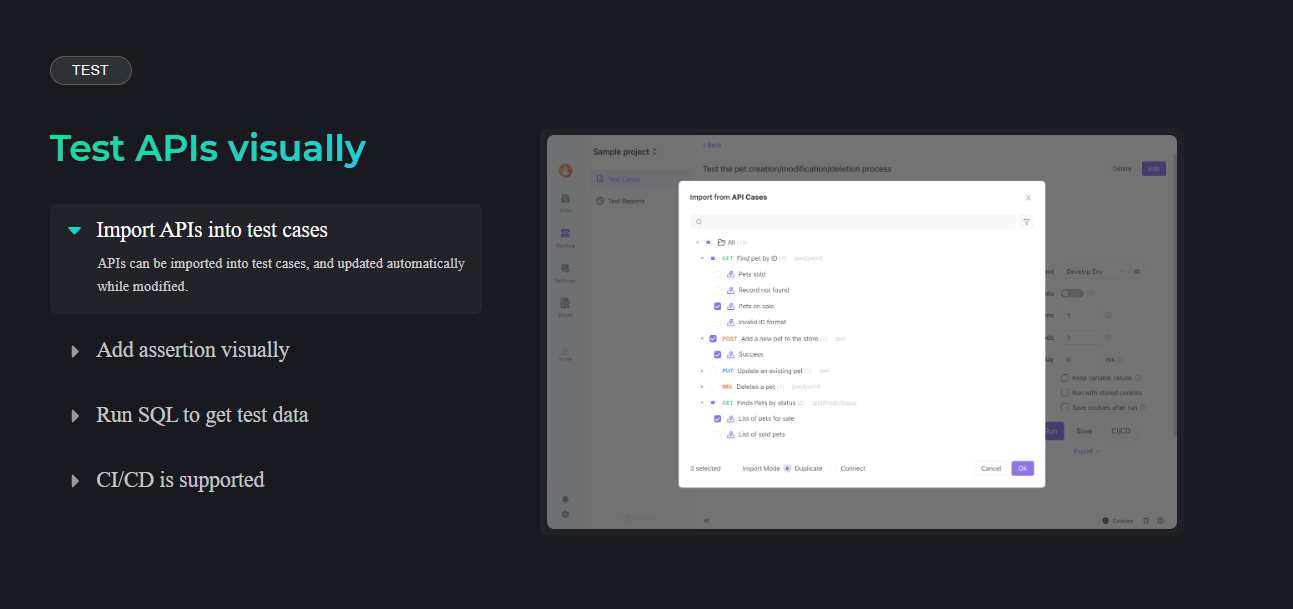
Assertion
Apidog is an all-encompassing tool that simplifies verifying API responses. It offers a range of pre-existing assertions; you can customise them to align with your testing requirements.

Security
Apidog provides security features, such as user authentication and role-based access control, to protect sensitive API documentation. This feature is particularly important for developers working on projects that involve sensitive or confidential data. By implementing user authentication and access control, Apidog helps prevent unauthorized access to the API documentation, ensuring that sensitive information remains secure.

Collaboration
Apidog's collaboration features allow you to share tests and results with your team seamlessly. Your team can collaborate more efficiently to build and maintain high-quality APIs by fostering effective communication and collaboration.

Comprehensive Customer Support
Apidog offers customer support via email, chat, knowledge base, and community forums. This support is helpful for developers needing help with specific features.
Detailed Reports
Apidog provides comprehensive reports and analytics that offer valuable insights into your API performance. With these detailed reports, you can quickly identify areas for improvement and optimize your APIs for better performance and reliability.

API Integration
Apidog enables easy integration of APIs with various platforms and tools, including commonly used development frameworks and tools. This integration feature streamlines linking APIs with other services, providing developers with more flexibility and convenience.

Kickstart Your API Testing Journey with Apidog: A Comprehensive Guide
Embarking on your Apidog journey is a breeze. This comprehensive guide will walk you through the steps to set up your account and easily create, execute, and manage API tests.
Sign Up for an Apidog Account
Visit Apidog’s website to create a new account. You can also log in with Google or Github.
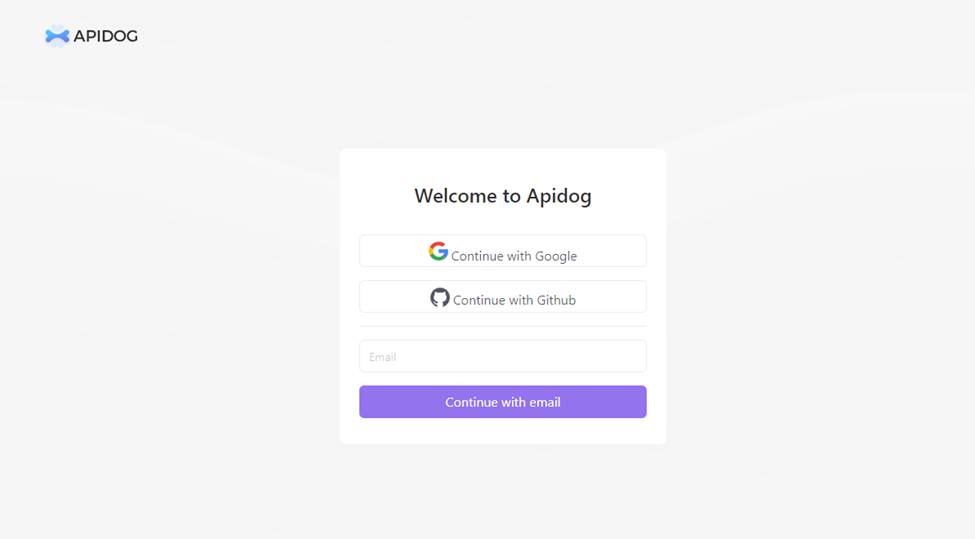
Set Up Your Workspace
After logging in, you'll be greeted with the Apidog dashboard. Start by setting up a new workspace to organize your API tests. Workspaces allow you to collaborate with your team and keep your tests organized.
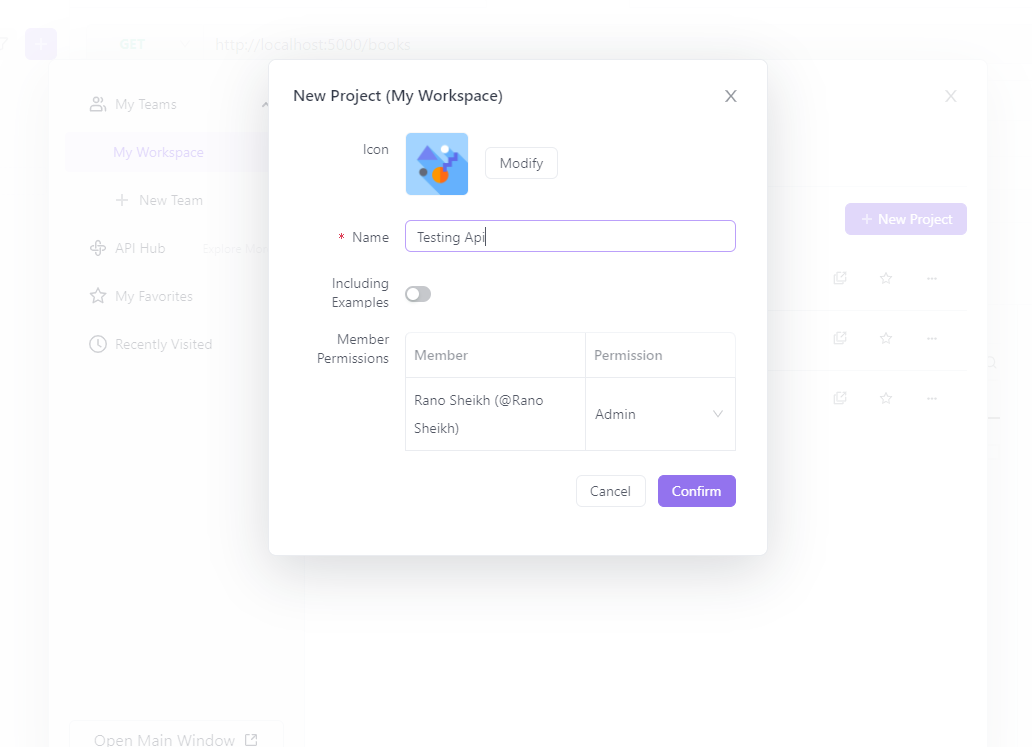
Create a New Project
Create a new project or import one within your workspace to group your API tests based on a specific application or service. It helps keep your tests organized and makes managing and maintaining them more accessible.

Add Your APIs
To add your API to Apidog, click the "Add API" button and provide the necessary details, including the endpoint, method, and authentication information. For example, To create the "GET all books" endpoint in Apidog, click on the "Add Endpoint" button and fill in the details like this:
- URL: http://localhost:5000/books
- Method: GET
- Endpoint name: Get all books
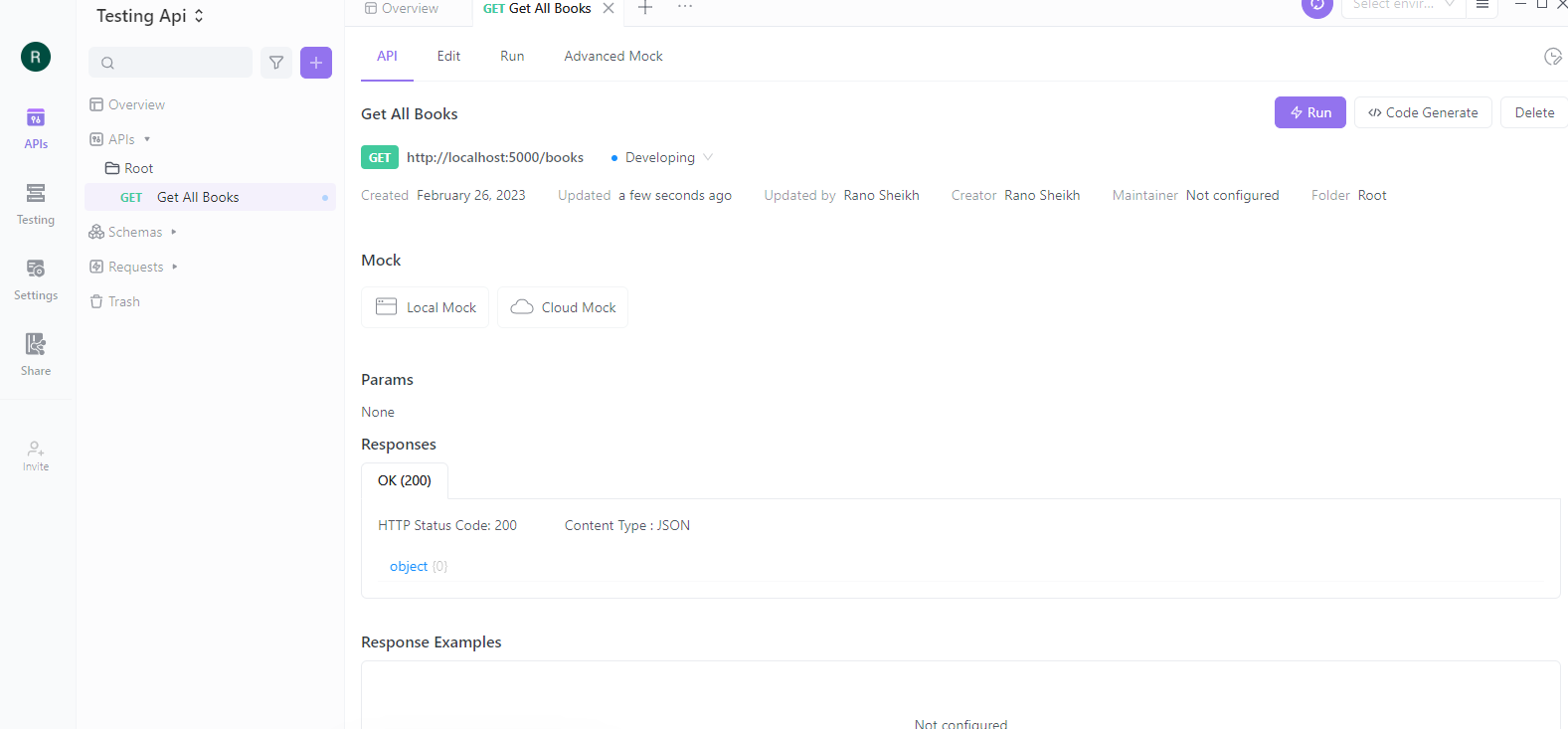
Configure Your APIs
Apidog's platform simplifies the management of multiple APIs from a single dashboard. The platform also supports a range of authentication methods, including OAuth and API keys, to ensure secure access to your APIs. It allows developers to choose the authentication method best suits their project's requirements.

Design Your Test Scenarios
Using Apidog's Visual API Builder, create test scenarios and assertions. The intuitive interface allows you to build complex test scenarios without writing any code.
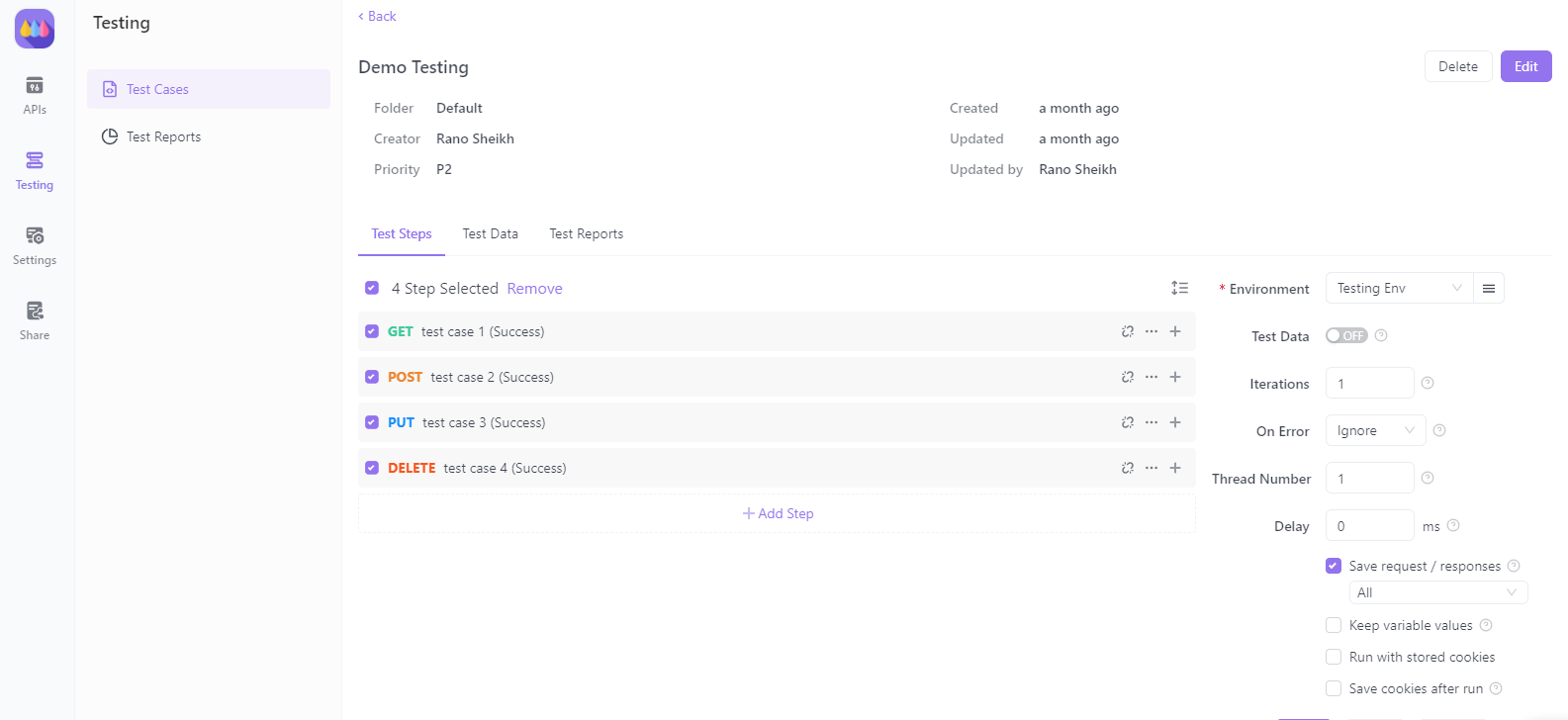
Run Your Tests
Apidog allows you to run tests individually or in groups, enabling you to thoroughly assess your APIs' functionality, reliability, and security.

Analyze Test Results and Optimize
After executing your tests, analyze the results using Apidog's detailed reports and analytics. Identify areas for improvement, optimize your APIs, and ensure they meet the highest performance and reliability standards.

For a more detailed walkthrough, check out the Apidog Getting Started Guide. By following these steps, you'll be well on your way to mastering API testing automation with Apidog and improving your development workflow.
Apidog Performance Testing
Apidog is a comprehensive API testing tool that offers multiple ways to perform performance testing on your APIs. By understanding the response times, throughput, and potential bottlenecks, you can optimize your APIs for better user experience and reliability. Apidog provides three approaches for performance testing, giving you the flexibility to choose the method that best suits your requirements.
Apidog In-App Testing (Beta):
Apidog's in-app testing allows you to conduct performance testing directly within the platform. To perform this test, simply set the number of threads to a value greater than 1 when running test cases. The number of threads represents the concurrent processes executing the selected steps in order. It's important to note that this feature is in beta and still being optimized. Apidog recommends using JMeter for high-concurrency testing.
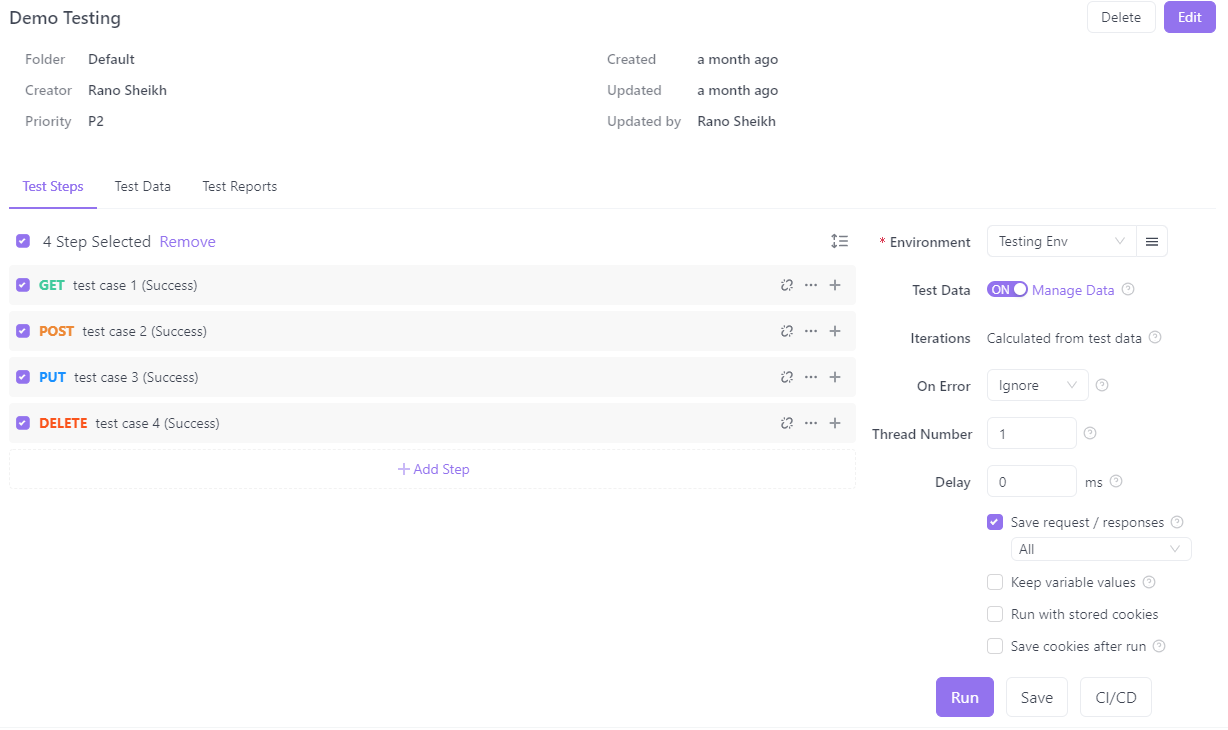
Apidog CLI Testing:
Apidog CLI is a command-line tool designed for continuous integration. While the stress testing feature is under development, You can use Apidog CLI for running tests with real-time data directly from the Apidog platform or using exported data from the test case page.

JMeter Testing:
Apidog allows you to export test cases in JMeter format and import them into JMeter for performance testing. JMeter is a popular open-source tool for load testing and measuring the performance of web applications and APIs, making it a great choice for assessing the performance of your APIs.
In addition to performance testing, Apidog integrates with Jenkins for continuous integration. Installing Jenkins and the Apidog CLI on your server allows you to set up a Node.js environment with Jenkins, create Jenkins tasks, and execute Apidog CLI commands. This seamless integration lets you view and publish test reports using the Jenkins HTML Publisher plugin.
Collaborative API Testing: Uniting Your Team with Apidog
Discover how Apidog's collaboration features can unite your team, foster effective communication, and streamline API testing.
Create a Workspace
Apidog workspaces enable you to organize projects and collaborate with team members. Create a workspace by clicking the "Add Workspace" button on the Apidog dashboard.
Invite Team Members
Invite your team members to join your workspace by clicking the "Invite" button in the workspace settings. Enter your colleagues' email addresses, and you will invite them to join your workspace.

Assign Roles and Permissions
Control access to projects and resources within your workspace by assigning roles and permissions to team members. Apidog supports various roles, such as administrator, editor, and viewer, ensuring each team member has the appropriate level of access.

Collaborate on Test Design and Execution
Work with your team to design, execute, and analyze API tests within your shared workspace. Team members can comment on test runs, fostering communication and collaboration around test results and improvements.
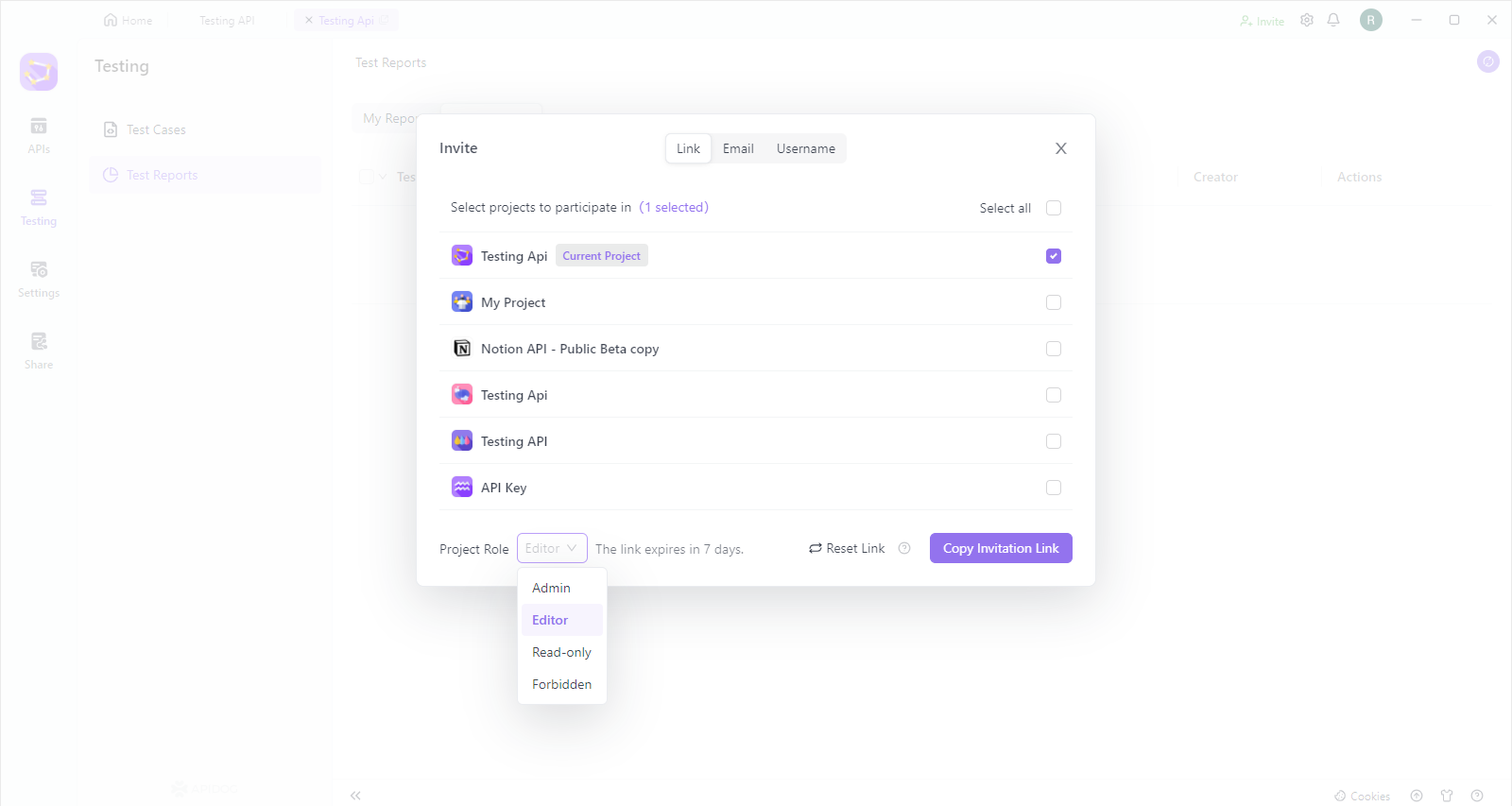
Conclusion: Experience the Apidog Advantage
In this exploration of automated API testing and Apidog, this post highlighted the powerful features, benefits, and insights that make Apidog the ultimate choice for your API testing needs. By integrating Apidog into your development workflow and leveraging its collaboration capabilities, you can significantly improve the efficiency of your API testing process, reduce human error, and ensure that your software delivers the best possible user experience.
So, are you ready to accelerate your API development workflow? Join the Apidog community by signing up for free today and take your API development to the next level.




